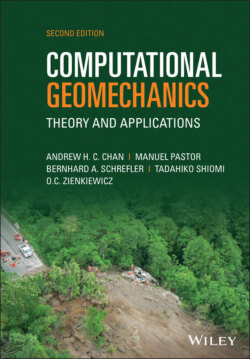Читать книгу Computational Geomechanics - Manuel Pastor - Страница 27
2.4.2 The Governing Equation
ОглавлениеThe dynamics of the total mixture can, just as in Section 2.3, be written in precisely the same form as that for a single fluid phase (see (2.11)). For completeness, we repeat that equation here (now, however, a priori omitting the small convective terms)
(2.34a)
(2.34b)
However, just as in Equation (2.25), we have to write
(2.35)
noting that
For definition of effective stress, we again use (2.24) now, however, without equating the air pressure to zero, i.e. writing
(2.36)
For the flow of water and air, we can write the Darcy equations separately, noting that
(2.37a)
(2.37b)
for water as in (2.27) and for the flow of air:
(2.38a)
(2.38b)
Here we introduced appropriate terms for coefficients of permeability for water and air, while assuming isotropy. A new variable v now defines the air velocity.
The approximate momentum conservation Equation (see 2.13) can be rewritten in a similar manner using isotropy but omitting acceleration terms for simplicity. We therefore have for water
(2.39a)
(2.39b)
and for air
(2.40a)
(2.40b)
Finally, the mass balance equations for both water and air have to be written. These are derived in a manner identical to that used for Equation (2.30). Thus, for water, we have
(2.41a)
(2.41b)
and for air
(2.42a)
or
(2.42b)
Now, in addition to the solid phase displacement ui(u), we have to consider the water pressure pw and the air pressure pa as independent variables.
However, we note that now (see (1.21))
(2.43)
and that the relation between pc and SW is unique and of the type shown in Figure 1.6. pc now defines SW and from the fact that
(2.44)
air saturation can also be found.
We have now the complete equation system necessary for dealing with the flow of air and water (or any other two fluids) coupled with the solid phase deformation.
